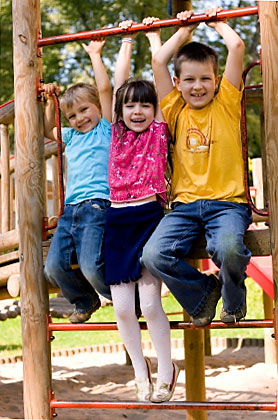
The Injustice Facing Juvenile Sex Offenders
October 25, 2012Student Blogs ArticleThere are many stereotypes floating around in today’s society about the prototypical sex offender. For example, if one were to imagine what such a person looks like, his or her ethnicity, and what he or she would be wearing, many of us would assume that this person is a 40-something white male with facial hair wearing a long trench coat (with perhaps nothing underneath) and outdated, though arguably retro, glasses from the 1970’s. He’s the guy creeping around the playground or luring kids into his sketchy van with the promise of a lollipop. I believe that this man exists. We don’t want him near our homes, and we certainly don’t want him near our children’s schools. We use the legal system to shame him and find out where he lives. He will forever live his life as a registered sex offender and be marked with one of the hundreds of stigmatic red pins dotting the neighborhoods of America.
But who are those other red pins? What if the person you don’t want near your home, or your child’s school, is another child?
In 1994, New Jersey passed the toughest sex offender registration act in the nation, known as Megan’s Law. The law was named after Megan Kanka, a seven year old who was raped and murdered by a sex offender out on parole. Her parents and the local community were outraged that they were not informed that a twice-convicted sex offender was living in their neighborhood. This started a movement that resulted in the passage of what came to be called “Megan’s Law.” Earlier in 1994, President Clinton had signed the Jacob Wetterling Crimes Against Children and Sexually Violent Registration Act requiring each state to establish a system for sex offender registration. Megan’s Law was added as an amendment to this federal law allowing each state to make its own guidelines for sex offender registration.
Thus, the sentence for sex offenders is not life in prison, but it is a life sentence. Megan’s Law requires that all convicted sex offenders register with local law enforcement agencies for the rest of their lives. All fifty states have sex offender registration, but the standards can vary from state to state, resulting in a confusing labyrinth of requirements. Although all fifty states have a sex offender database, only twenty-eight states require juveniles convicted of a sexual offense to register as sex offenders, five states require juveniles who have been tried as adults to register, and the other seventeen states require all juvenile sex offenders to register. These differences are based on the idea that young people who commit crimes are less culpable and more likely to be successfully rehabilitated than adults. This is the reason the juvenile justice system exists in the first place: there is something different about children. It also seems, however, that there is something different about sex crimes.
Now don’t get me wrong, I do see the bigger picture here. We want laws in place to punish sex offenders for a very good reason: we want to protect citizens, especially children, from such heinous crimes, which makes perfect sense…in theory. What doesn’t make sense, however, is the complete lack of clemency built into the system for these offenders, especially juveniles. Juvenile sex offenders are often more foolish than evil, more naïve and reckless than pedophilic. While it is true that juveniles commit 35.6% of sex crimes against minors, it is also true that only 5% to 14% of juvenile sex offenders re-offend compared with approximately 40% of adult sex offenders. The recidivism rate for juvenile sex offenses is substantially lower than the recidivism rates for other adolescent delinquent behavior, which can range from 8% to 58%.
But what about second chances? Can’t people change? It certainly doesn’t take much to convince someone that the person you are at sixteen is not the person you will be at forty-five. A sixteen-year-old boy certainly doesn’t fit the creeper-in-the-park stereotype of sex offenders. The solution, it seems, is to separate the boys from the men (so to speak—since many sex offenders are women). In order to serve the goals of the juvenile justice system, we should not treat juveniles who commit sex crimes differently than we treat juveniles who commit other crimes. The Association for the Treatment of Sexual Offenders (ATSO) recommends that young sex offenders be treated with juvenile-specific, community-based treatment as an alternative to the adult criminal justice system whenever possible. Additionally, ATSO suggests that juveniles should be subjected to community notification procedures in only the most extreme cases. The juvenile justice system was set up in order to deal with the unique circumstances surrounding crimes committed by young individuals. Our legal system treats juvenile offenders differently for a reason. Juvenile sex offences should not be exceptions to this regime; they should be a central part of it.
You may also like
5 comments
- March 2025
- February 2025
- November 2024
- October 2024
- April 2024
- March 2024
- February 2024
- November 2023
- October 2023
- April 2023
- March 2023
- February 2023
- January 2023
- December 2022
- November 2022
- October 2022
- May 2022
- April 2022
- March 2022
- February 2022
- January 2022
- December 2021
- November 2021
- October 2021
- May 2021
- April 2021
- March 2021
- February 2021
- January 2021
- November 2020
- October 2020
- September 2020
- August 2020
- July 2020
- June 2020
- May 2020
- April 2020
- March 2020
- February 2020
- January 2020
- November 2019
- October 2019
- September 2019
- April 2019
- February 2019
- December 2018
- November 2018
- October 2018
- September 2018
- March 2018
- February 2018
- January 2018
- December 2017
- November 2017
- October 2017
- September 2017
- May 2017
- April 2017
- March 2017
- February 2017
- December 2016
- November 2016
- October 2016
- April 2016
- March 2016
- February 2016
- January 2016
- December 2015
- November 2015
- October 2015
- June 2015
- May 2015
- April 2015
- March 2015
- February 2015
- January 2015
- December 2014
- November 2014
- October 2014
- August 2014
- March 2014
- February 2014
- January 2014
- December 2013
- November 2013
- October 2013
- September 2013
- May 2013
- April 2013
- March 2013
- February 2013
- January 2013
- December 2012
- November 2012
- October 2012
- September 2012
- June 2012
- April 2012
- March 2012
- February 2012
- January 2012
- December 2011
- November 2011
- October 2011
- September 2011
- August 2011
- April 2011
- March 2011
- November 2010
- October 2010
- September 2010

This is a thoughtful post, and especially relevant in light of of this term’s Supreme Court decision on juvenile life sentences (Miller v. Alabama).
Miller struck down mandatory life without parole sentencing schemes for juveniles, in large part reflecting on the capacity of children to be rehabilitated. It seems the functional equivalent of a life sentence in the sex-offender context is indeed requiring a lifelong sex-offender registration, and Miller could be extended to strike those down also.
This is an excellent piece except for one glaring problem… recidivism rates for adult sex offenders are absolutely not 40%. They have consistently been documented in the single digits, long before AND after the registry. Please visit my library of studies for 20+ studies from university, state and federal institutions, all of which found single-digit re-offense rate: http://www.endsexcrime.org/theproof.html#recidivism.
I do agree that the ATSO’s suggestion of juvenile-specific, community-based treatment as an alternative would be a good idea, because I think you are right in that the ultimate goal of the juvenile justice system is to rehabilitate juveniles rather than just punish them. However, I disagree with the idea that juvenile sex offenders will be required to follow notification procedures only in the most extreme cases. I actually think that a good response to this problem is to do what only 5 states do – to require juveniles to register when they are tried as adults for their crimes. What will most likely happen under that type of system is that the juveniles who are tried as adults will be those who committed the most extreme crimes, but it will remove the vagueness of what constitutes an “extreme case.” I believe that this would be a solution in keeping with the goals of the juvenile justice system.
I think the topic of juvenile sex offenders is extremely interesting, as there seems to have been a rise in the number of sexual offenses committed by juveniles in recent decades (although some experts have suggested that the number of these offenses has not gone up at all… rather, these offenses are merely reported more often and there are more laws in place that apply to juveniles). Nevertheless, this seems to be a problem. I don’t, however, think that all of the focus should be placed on what we do to reform these juvenile offenders. Research suggests that between 40 and 80 percent of juvenile offenders have previously been molested, themselves, and that 42 percent of these juvenile offenders had seen hardcore pornography. Perhaps I’m being naïve, but I think if we continue to crack down on adult sex offenders, and make efforts to reduce the rate of children’s exposure to pornography, the rate of juvenile sex offenses may be held in check, as well. Though I guess it’s just about impossible to prevent children from seeing pornography.. I heard a story the other day about a 5 year old bringing his own functioning iPhone to school.. With the prevalence of pornography online, and the seemingly unlimited access children have to technology and to the internet, I guess it’s an uphill battle.
Nothing can justify branding a juvenile as a monster.